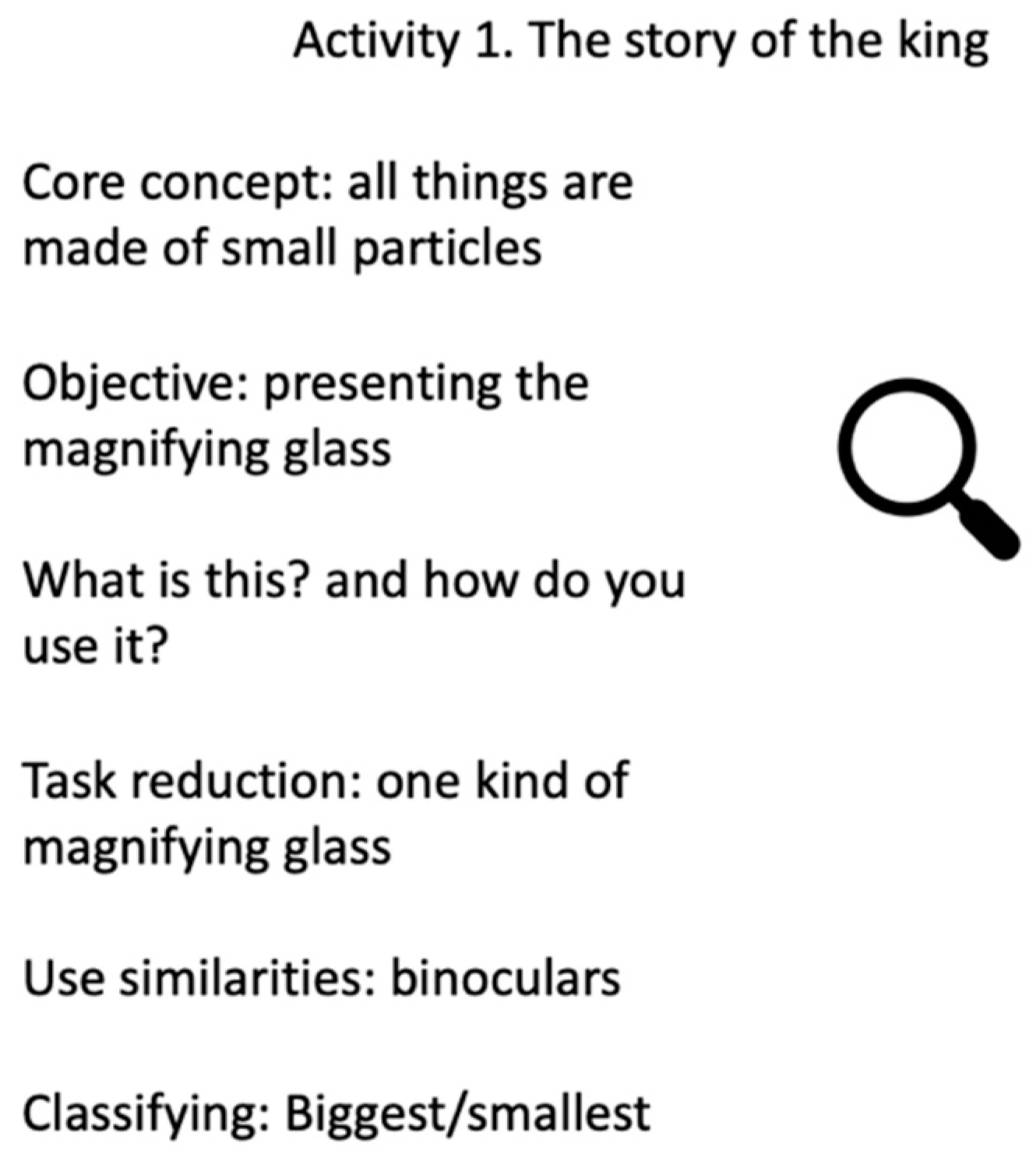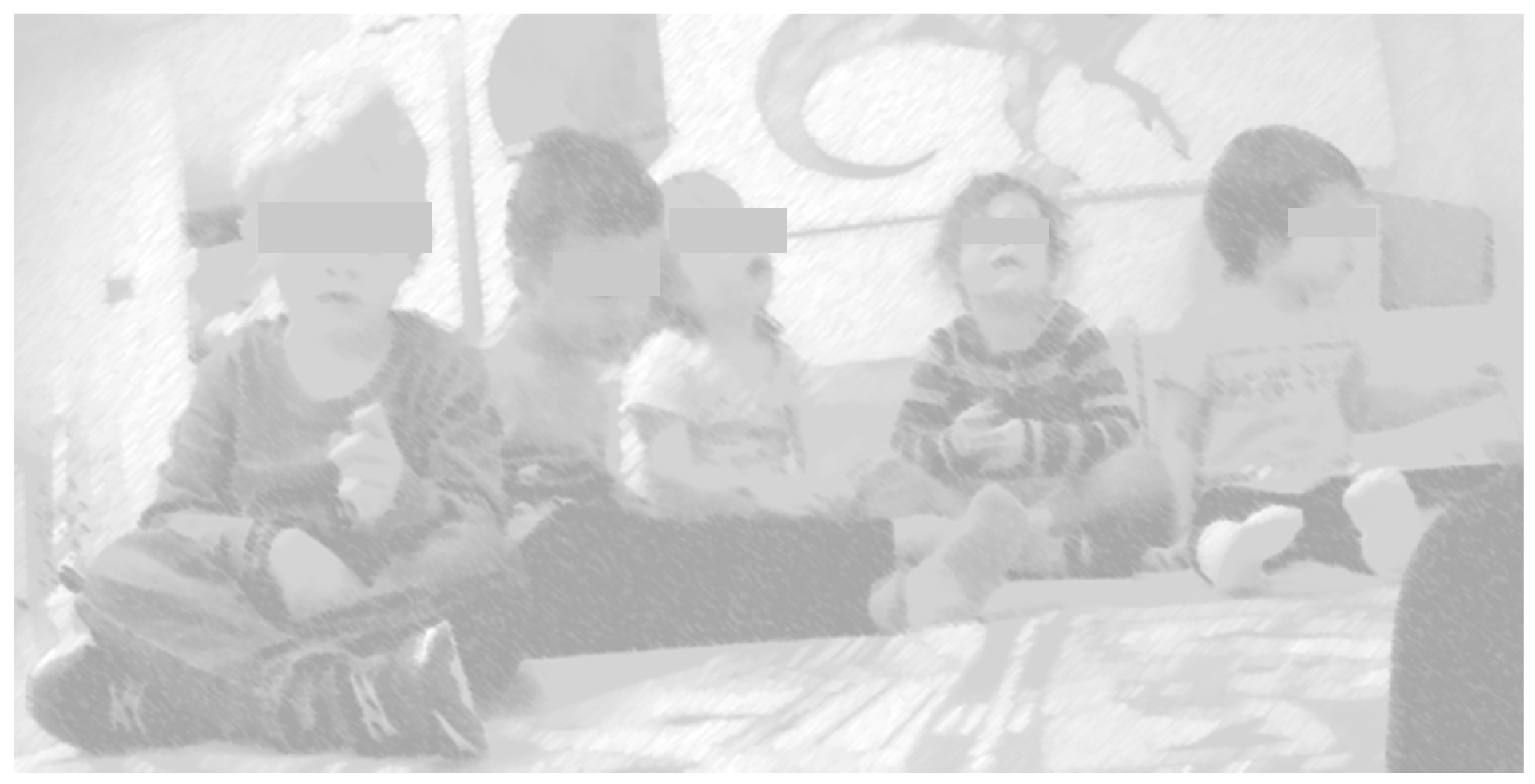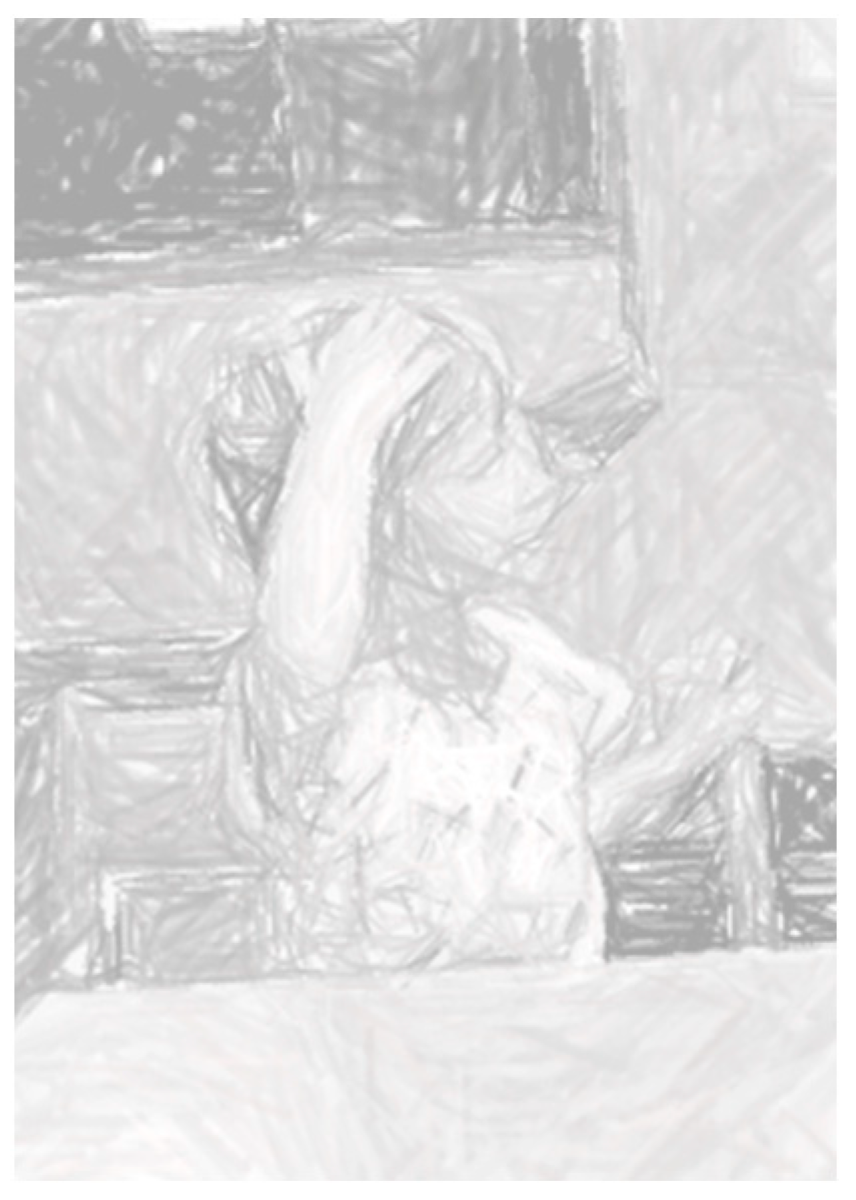Development of Preschool Children’s Executive Functions throughout a Play-Based Learning Approach That Embeds Science Concepts
Abstract
1. Introduction
1.1. Introducing Science to Preschool Children
1.2. Self-Regulation Skills from an Adult Metacognition Perspective
1.3. Different Types of Skills Supporting the Developmental Perspective of Executive Functions
1.4. Research on Improving EF Skills
2. Materials and Methods
2.1. Study Design
2.2. Data Analysis
3. Results
3.1. The First Set of Activities
3.2. Summary
4. Discussion
5. Conclusions
Author Contributions
Funding
Institutional Review Board Statement
Informed Consent Statement
Acknowledgments
Conflicts of Interest
References
- Conezio, K.; French, L. Science in the preschool classroom—Capitalizing on children’s fascination with the everyday world to foster language and literacy development. Young Child. 2002, 57, 12–18. [Google Scholar]
- Eshach, H.; Fried, M.N. Should Science be Taught in Early Childhood? J. Sci. Educ. Technol. 2005, 14, 315–336. [Google Scholar] [CrossRef]
- Ferreira, J.A.; Paiva, J.; Grande, C. Hands-on chemistry in preschool education: Experiments executed by little “scientists” in kindergarten. Comunicacoes 2017, 24, 99–112. [Google Scholar]
- Fleer, M. A Cultural-Historical Model of Early Childhood Science Education; Springer Science and Business Media LLC: Berlin, Germany, 2014; pp. 199–213. [Google Scholar]
- Henrichs, L.F.; Leseman, P.P. Early Science Instruction and Academic Language Development Can Go Hand in Hand. The Promising Effects of a Low-Intensity Teacher-Focused Intervention. Int. J. Sci. Educ. 2014, 36, 2978–2995. [Google Scholar] [CrossRef]
- Klaar, S.; Öhman, J. Action with friction: A transactional approach to toddlers’ physical meaning making of natural phenomena and processes in preschool. Eur. Early Child. Educ. Res. J. 2012, 20, 439–454. [Google Scholar] [CrossRef]
- Mantzicopoulos, P.; Patrick, H. “The Seesaw Is a Machine That Goes Up and Down”: Young Children’s Narrative Responses to Science-Related Informational Text. Early Educ. Dev. 2010, 21, 412–444. [Google Scholar] [CrossRef]
- Monteira, S.F.; Jiménez-Aleixandre, M.P. The practice of using evidence in kindergarten: The role of purposeful observation. J. Res. Sci. Teach. 2015, 53, 1232–1258. [Google Scholar] [CrossRef]
- Ravanis, K.; Papandreou, M.; Kampeza, M.; Vellopoulou, A. Teaching activities for the construction of a precursor model in 5- to 6-year-old children’s thinking: The case of thermal expansion and contraction of metals. Eur. Early Child. Educ. Res. J. 2013, 21, 514–526. [Google Scholar] [CrossRef]
- Siry, C.; Kremer, I. Children Explain the Rainbow: Using Young Children’s Ideas to Guide Science Curricula. J. Sci. Educ. Technol. 2011, 20, 643–655. [Google Scholar] [CrossRef]
- Van der Aalsvoort, G.M.; Bouwense, E.; Kok-Baarda, M. The relationship between patterns applied while using software to observe natural phenomena and understanding those concepts by kindergarten students. Educ. Child Psychol. 2008, 25, 74–86. [Google Scholar]
- Allen, M. Preschool children’s taxonomic knowledge of animal species. J. Res. Sci. Teach. 2014, 52, 107–134. [Google Scholar] [CrossRef]
- Danish, J. Applying an Activity Theory Lens to Designing Instruction for Learning About the Structure, Behavior, and Function of a Honeybee System. J. Learn. Sci. 2014, 23, 100–148. [Google Scholar] [CrossRef]
- Elmesky, R. Building Capacity in Understanding Foundational Biology Concepts: A K-12 Learning Progression in Genetics Informed by Research on Children’s Thinking and Learning. Res. Sci. Educ. 2012, 43, 1155–1175. [Google Scholar] [CrossRef]
- Witt, S.D.; Kimple, K.P. “How does your garden grow?” Teaching preschool children about the environment. Early Child Dev. Care 2008, 178, 41–48. [Google Scholar] [CrossRef]
- Christidou, V.; Hatzinikita, V. Preschool Children’s Explanations of Plant Growth and Rain Formation: A Comparative Analysis. Res. Sci. Educ. 2005, 36, 187–210. [Google Scholar] [CrossRef]
- Hadzigeorgiou, Y.A. Study of the Development of the Concept of Mechanical Stability in Preschool Children. Res. Sci. Educ. 2002, 32, 373–391. [Google Scholar] [CrossRef]
- Levy, S.T. Young children’s learning of water physics by constructing working systems. Int. J. Technol. Des. Educ. 2012, 23, 537–566. [Google Scholar] [CrossRef]
- Nayfeld, I.; Brenneman, K.; Gelman, R. Science in the classroom: Finding a balance between autonomous exploration and teacher-led instruction in preschool settings. Early Educ. Dev. 2011, 22, 970–988. [Google Scholar] [CrossRef]
- Lin, H.; Lawrence, F.R.; Gorrell, J. Kindergarten teachers’ views of children’s readiness for school. Early Child. Res. Quart. 2003, 18, 225–237. [Google Scholar] [CrossRef]
- Bierman, K.L.; Torres, M. Promoting the development of executive functions through early education and prevention programs. In Executive Function in Preschool-Age Children: Integrating Measurement, Neurodevelopment, and Translational Research; Griffin, J.A., McCardle, P., Freund, L.S., Eds.; American Psychological Association: Washington, DC, USA, 2016; pp. 299–326. [Google Scholar]
- Walker, S.; Fleer, M.; Veresov, N.; Duhn, I. Enhancing executive function through imaginary play: A promising new practice principle. Australas J. Early Child. 2020, 45, 114–126. [Google Scholar] [CrossRef]
- Diamond, A. Executive functions. Ann. Rev. Psychol. 2013, 64, 135–168. [Google Scholar] [CrossRef] [PubMed]
- Griffin, J.A.; Freund, L.S.; McCardle, P.; DelCarmen-Wiggins, R.; Haydon, A. Introduction to Executive Function in Preschool-Age Children. In Executive Function in Preschool-Age Children: Integrating Measurement, Neurodevelopment and Translational Research; American Psychological Association (APA): Worcester, MA, USA, 2016; pp. 3–7. [Google Scholar]
- Miyake, A.; Friedman, N.P.; Emerson, M.J.; Witzki, A.H.; Howerter, A.; Wager, T.D. The unity and diversity of executive functions and their contributions to complex “Frontal Lobe” tasks: A latent variable analysis. Cognit. Psychol. 2000, 41, 49–100. [Google Scholar] [CrossRef] [PubMed]
- Davidson, M.C.; Amso, D.; Anderson, L.C.; Diamond, A. Development of cognitive control and executive functions from 4 to 13 years: Evidence from manipulations of memory, inhibition, and task switching. Neuropsychology 2006, 44, 2037–2078. [Google Scholar] [CrossRef] [PubMed]
- Hofmann, W.; Schmeichel, B.J.; Baddeley, A.D. Executive functions and self-regulation. Trends Cognit. Sci. 2012, 16, 174–180. [Google Scholar] [CrossRef]
- Cepeda, N.J.; Kramer, A.F.; Gonzales de Sather, J.C. Changes in executive control across the life span: Examination of task-switching performance. Dev. Psychol. 2001, 37, 715–730. [Google Scholar] [CrossRef]
- Zelazo, P.D.; Muller, U. The balance beam in the balance: Reflections on rules, relational complexity, and developmental processes. J. Exp. Child Psychol. 2002, 4, 458–465. [Google Scholar] [CrossRef]
- Flavell, J.H.; Saltas, H. Perspective taking: The development of two components of knowledge. Child Dev. 1976, 1, 103–109. [Google Scholar]
- Fridman, R.; Eden, S.; Spektor-Levy, O. Nascent Inquiry, Metacognitive, and Self-Regulation Capabilities Among Preschoolers During Scientific Exploration. Front. Psychol. 2020, 11, 1790. [Google Scholar] [CrossRef]
- Blair, C.; Raven, C.C. School readiness and self-regulation: A developmental psychobiological approach. Ann. Rev. Psychol. 2015, 66, 711–731. [Google Scholar] [CrossRef]
- Vygotsky, L.S. Play and its role in the mental development of the child. Int. Res. Early Child. Educ. 2016, 7, 3–25. [Google Scholar] [CrossRef]
- Kopp, C.B. Antecedents of self-regulation: A developmental perspective. Dev. Psychol. 1982, 18, 199–214. [Google Scholar] [CrossRef]
- Barkley, R.A. Executive functioning and self-regulation viewed as an extended phenotype: Implications of the theory for ADHD and its treatment. In Attention-Deficit Hyperactivity Disorder: A Handbook for Diagnosis and Treatment; The Guilford Press: New York, NY, USA, 2015; pp. 405–434. [Google Scholar]
- Klingberg, T.; Fernell, E.; Olesen, P.J.; Johnson, M.; Gustafsson, P.; Dahlström, K.; Gillberg, C.G.; Forssberg, H.; Westerberg, H. Computerized training of working memory in children with ADHD—A randomized, controlled trial. J. Am. Acad. Child Adolesc. Psych. 2005, 44, 177–186. [Google Scholar] [CrossRef] [PubMed]
- Rueda, M.R.; Posner, M.I.; Rothbart, M.K. The Development of Executive Attention: Contributions to the Emergence of Self-Regulation. Dev. Neuropsychol. 2005, 28, 573–594. [Google Scholar] [CrossRef] [PubMed]
- Bernier, A.; Carlson, S.M.; Deschênes, M.; Matte-Gagné, C. Social factors in the development of early executive functioning: A closer look at the caregiving environment. Dev. Sci. 2011, 15, 12–24. [Google Scholar] [CrossRef] [PubMed]
- Bers, M.U.; Flannery, L.; Kazakoff, E.R.; Sullivan, A. Computational thinking and tinkering: Exploration of an early childhood robotics curriculum. Comp. Educ. 2014, 72, 145–147. [Google Scholar] [CrossRef]
- Alimisis, D. Educational robotics: Open questions and new challenges. Themes Sci. Technol. Educ. 2020, 6, 63–71. [Google Scholar]
- Fleer, M. ‘Conceptual Play’: Foregrounding Imagination and Cognition during Concept Formation in Early Years Education. Contemp. Issues Early Child. 2011, 12, 224–240. [Google Scholar] [CrossRef]
- Siraj-Blatchford, I. Conceptualising progression in the pedagogy of play and sustained shared thinking in early childhood education: A Vygotskian perspective. Educ. Psychol. 2009, 26, 77–89. [Google Scholar]
- Hedegaard, M. The educational experiment. In Studying Children: A Cultural-Historical Perspective; Hedegaard, M., Fleer, M., Eds.; Open University Press: New York, NY, USA, 2008; pp. 181–201. [Google Scholar]
- Adbo, K.; Carulla, C.V. Designing play-based learning chemistry activities in the preschool environment. Chem. Educ. Res. Pract. 2019, 20, 542–553. [Google Scholar] [CrossRef]
- Adbo, K.; Vidal Carulla, C. Learning about Science in Preschool: Play-Based Activities to Support Childrens Understanding of Chemistry Concepts. Int. J. Early Child. 2020, 52, 17–35. [Google Scholar] [CrossRef]
- Pink, S. Doing Visual Ethnography; SAGE Publications: Thousand Oaks, CA, USA, 2007. [Google Scholar]



| Stage 1 | Activity Number | Content of Session |
| 250118 | 1 | The story of the king |
| 300118 | 2 | The magnifying glass |
| 010218 | 3 | Close-up videos |
| 060218 | 4 | The magnifying glass |
| 080218 | 5 | Where did the sugar go? |
| 130218 | 6 | Dissolving |
| 150218 | 7 | Filtering |
| 080518 | 8 | Baking |
| 150518 | 9 | Touching |
| 220518 | 10 | Smelling |
| 300518 | 11 | Hearing |
| 310518 | 12 | Disassembly of chocolate ball |
| 070618 | 13 | Recollecting |
| Summer Break | ||
| Stage 2 | Activity Number | Content of Session |
| 151018 | 14 | Disassembly of Lego |
| 181018 | 15 | Disassembly of salt and sugar |
| 231018 | 16 | Disassembly of bath bomb |
| 251018 | 17 | Zooming-in video |
| 080119 | 18 | Zooming-in video |
| 100119 | 19 | Zooming-in video |
| 150119 | 20 | Disassembly of sugar |
| 170119 | 21 | Changes of state |
| 190319 | 22 | States of matter |
| 200319 | 23 | Zooming-in videos |
| 090419 | 24 | Mixing |
| IC (Body Language) |
|---|
| Shifting focus to the surroundings (picking up items) |
| Moving around (jumping, standing, dancing) Moving close to the teacher |
| Eye contact with the teacher and little movement |
Publisher’s Note: MDPI stays neutral with regard to jurisdictional claims in published maps and institutional affiliations. |
© 2021 by the authors. Licensee MDPI, Basel, Switzerland. This article is an open access article distributed under the terms and conditions of the Creative Commons Attribution (CC BY) license (http://creativecommons.org/licenses/by/4.0/).
Share and Cite
Vidal Carulla, C.; Christodoulakis, N.; Adbo, K. Development of Preschool Children’s Executive Functions throughout a Play-Based Learning Approach That Embeds Science Concepts. Int. J. Environ. Res. Public Health 2021, 18, 588. https://doi.org/10.3390/ijerph18020588
Vidal Carulla C, Christodoulakis N, Adbo K. Development of Preschool Children’s Executive Functions throughout a Play-Based Learning Approach That Embeds Science Concepts. International Journal of Environmental Research and Public Health. 2021; 18(2):588. https://doi.org/10.3390/ijerph18020588
Chicago/Turabian StyleVidal Carulla, Clara, Nikolaos Christodoulakis, and Karina Adbo. 2021. "Development of Preschool Children’s Executive Functions throughout a Play-Based Learning Approach That Embeds Science Concepts" International Journal of Environmental Research and Public Health 18, no. 2: 588. https://doi.org/10.3390/ijerph18020588
APA StyleVidal Carulla, C., Christodoulakis, N., & Adbo, K. (2021). Development of Preschool Children’s Executive Functions throughout a Play-Based Learning Approach That Embeds Science Concepts. International Journal of Environmental Research and Public Health, 18(2), 588. https://doi.org/10.3390/ijerph18020588






